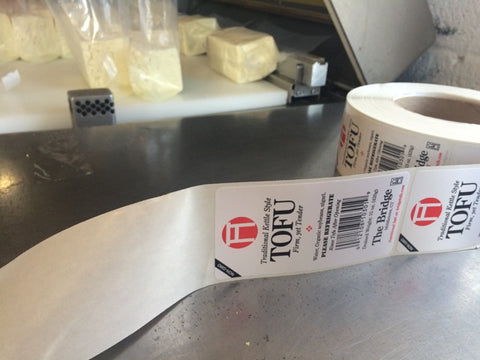On a recent trip to Bridge, a tofu-maker in Middletown, Connecticut, I saw actual people making actual tofu. The process from soybean to tofu is relatively straightforward – soaking, boiling, straining, pressing, cooling, and finally cutting. But as one of the tofu creators told me, “Making great tofu takes practice and patience.”

As someone who doesn’t like tofu, but really likes Bridge Tofu (don’t worry, Bridge isn’t sponsoring me!), my visit to the company answered my question: “What makes this tofu so different than all other tofu?” The answer is in how the product is made: carefully, consistently, with minimal technology and maximum humanity.
Both jewelry and tofu can be mass-produced by machines or individually crafted by hand. If you rush, or rely on machinery to do the work for you, the lack of care results in a lesser quality, texture, and overall feel (some might even say energy) of the final product.
This isn’t to dismiss the role of technology in the creative process. Bridge has a soybean grinder and a big vat boiler; I have a whole workbench of tools and a big polishing machine. But for Bridge, the equipment is used as an aide to those who are creating - just like the way I make my jewelry.

This presents a challenge: many people have tried tofu and don’t like it, and so they wouldn’t try another brand of tofu, because all tofu is the same, right? Similarly, many people have expectations about the price and quality of jewelry (based on mass-production processes), and perhaps negative associations of environmental impact (based on large-scale metal and mineral mining). And so I felt a kinship with the folks making the tofu at bridge – we’re both selling a very recognizable product type, yet the difference lies in how we create and manufacture our work.
The tricky part, as small business owners, is that the production process is entirely hidden from the final product and thus from our customers. Bridge tofu doesn’t necessarily look “handmade,” and with my jewelry I make sure to hide the tracks of production with clean solder seams and snug bezels. Bridge sources their organic soybeans locally, as I do with all of my recycled precious metals and minerals. It's important to ensure that we both share our stories with our customers, so they understand the extraordinary care and effort that goes into making our products.

Though my jewelry (or Bridge's tofu) may look, feel, (and taste) "better" than other seemingly similar items available, it's always helpful to know why and how they end up that way. Through my blog, instagram, facebook, and craft shows, I am constantly working to convey what makes Beryllina jewelry special.
As the proud owner of exquisite Beryllina jewelry, and a consumer of tofu, I loved reading this blog entry. The creative process is indeed fundamentally dependent on patience and precision. When those qualities are augmented by consideration for our planet, the results are not only beautiful and individual (or delicious, as in the case of Bridge tofu) but are also representative of the best we can do for ourselves and for future generations. thanks, Laurie!
Laurie Lynn Berezin
Author